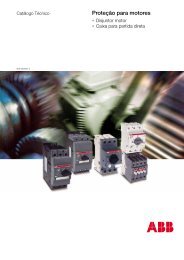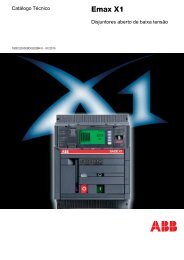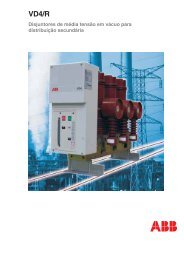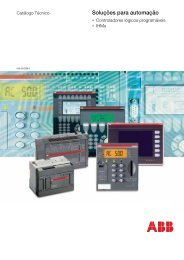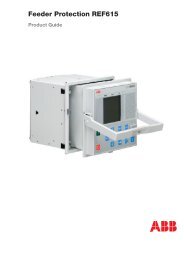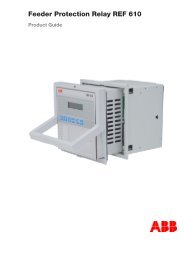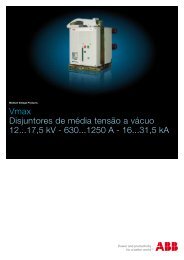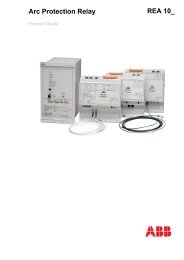Electricity meters for modular enclosures and DIN rail
Electricity meters for modular enclosures and DIN rail
Electricity meters for modular enclosures and DIN rail
You also want an ePaper? Increase the reach of your titles
YUMPU automatically turns print PDFs into web optimized ePapers that Google loves.
DELTAmaxGeneric in<strong>for</strong>mation - Time dependent functionsInternal clock <strong>and</strong> time dependantfunctionsDELTAmax meter has an internal clock that keeps track of thedate <strong>and</strong> time <strong>and</strong> is equipped with various time dependantfunctions such as load profile, maximum dem<strong>and</strong>, previousvalues, event log, outputs controlled by time <strong>and</strong> in tariffs.The tariffs are normally controlled via the internal clock (noexternal time switch required).The previous values, load profile, maximum dem<strong>and</strong> <strong>and</strong> theevent log functions are only readable via bus.Changing the default settings of these functions are only possibleby serial communication.If the time <strong>and</strong> date are not set no values will be registered.If all the memory available <strong>for</strong> a time dependant function isused, the oldest recorded data <strong>for</strong> that function will be overwritten.Changing interval length or number of values to be stored<strong>for</strong> a function will reset all values stored.Internal clockThe internal clock has a built in calendar <strong>and</strong> keeps automaticallytrack of leap year <strong>and</strong> daylight savings time (DST).DST function is optional.Backup of the clock during a power failure is provided by asupcapacitor. The time is controlled from a quartz crystal basedreal time clock. Time <strong>and</strong> date is set via the buttons or via communications.The internal clock is approved according to IEC 62052-21<strong>and</strong> IEC 62054-21 which contains particular requirements <strong>for</strong>time switches. The stated accuracy is less than 5 ppm at roomtemperature when controlled from the quartz crystal based realtime clock.Previous valuesThe monthly value feature will store all energy registers <strong>and</strong>input counter values altogether with a date/time stamp upon achange of day or month. All total energy values are stored <strong>and</strong>in <strong>meters</strong> equipped with the tariff feature all the tariff registerswill also be stored. The number of stored monthly values can beset from 0 to 127.Load profileIn the load profile function each day is divided into intervals ofa certain length where the energy consumption in each intervalis stored. The possible interval lengths are 15, 30 or 60 minutes.The default value is 60 minutes.The quantities that can be stored are active <strong>and</strong> reactive energywith the number of pulses registered on input 1 <strong>and</strong> 2. Storageof reactive energy is possible on combined <strong>meters</strong> only <strong>and</strong>storing of pulses requires <strong>meters</strong> with corresponding input.The load profile function always use st<strong>and</strong>ard time irrespectiveif the DST (daylight savings time) function is active or not.Maximum dem<strong>and</strong>In the maximum dem<strong>and</strong> function the time is divided into intervalsof a certain length <strong>and</strong> the mean power in each interval ismeasured <strong>and</strong> the maximum mean value is stored together witha date/time stamp. The possible interval lengths are 15, 30 or60 minutes <strong>and</strong> is programmable. Default value 15.For each set of maximum dem<strong>and</strong> values the end date/timeof the period is stored.The quantities that can be stored are active <strong>and</strong> reactive power<strong>and</strong> number of pulses registered on input 1 <strong>and</strong> 2 (pulses/interval).In tariff <strong>meters</strong> the maximum dem<strong>and</strong> is stored <strong>for</strong> eachtariff.The maximum number of maximum dem<strong>and</strong> values to be storedare programmable from 0 up to 127.Event logThe event log function can log the following events:• Overvoltage on each phase (+6%)• Undervoltage level 1 on each phase (-10%)• Undervoltage level 2 on each phase (-15%)• Phase voltage outage (-15%)• Negative power• Total power outageFor the over- <strong>and</strong> undervoltage events a percentage level inrespect to a nominal voltage is given which is programmable.For each registered event the start date/time <strong>and</strong> the duration(in seconds) is stored.The number of events to be stored are programmable from 0 upto 255.2CMC480022C0003| <strong>Electricity</strong> <strong>meters</strong> 41



